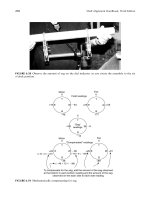Composite Materials Handbook Part 1 pot
Bạn đang xem bản rút gọn của tài liệu. Xem và tải ngay bản đầy đủ của tài liệu tại đây (61.57 KB, 15 trang )
MIL-HDBK-17-4
Volume 4 of 4
21 September 1999
DEPARTMENT OF DEFENSE
HANDBOOK
COMPOSITE MATERIALS HANDBOOK
VOLUME 4. METAL MATRIX COMPOSITES
This handbook is for guidance only. Do not cite this document as a requirement.
AMSC N/A AREA CMPS
DISTRIBUTION STATEMENT A. Approved for public release; distribution is unlimited.
NOT MEASUREMENT
SENSITIVE
MIL-HDBK-17-4
ii
FOREWORD
1.
This handbook is approved for use by all Departments and Agencies of the Department of Defense.
2.
This handbook is for guidance only. This handbook cannot be cited as a requirement. If it is, the
contractor does not have to comply. This mandate is a DoD requirement only; it is not applicable to
the Federal Aviation Administration (FAA) or other government agencies.
3.
Every effort has been made to reflect the latest information on composite materials. The handbook is
continually reviewed and revised to ensure its completeness and currentness. Documentation for the
secretariat should be directed to: Materials Sciences Corporation, MIL-HDBK-17 Secretariat, 500
Office Center Drive, Suite 250, Fort Washington, PA 19034.
4.
MIL-HDBK-17 provides guidelines and material properties for polymer (organic) and metal matrix
composite materials. The first three volumes of this handbook currently focus on, but are not limited
to, polymeric composites intended for aircraft and aerospace vehicles. The fourth volume currently
focuses on metal matrix composites (MMC). Ceramic matrix composites (CMC) and carbon/carbon
composites (C/C) will be covered in separate volumes as developments occur.
5.
This standardization handbook has been developed and is being maintained as a joint effort of the
Department of Defense and the Federal Aviation Administration.
6.
The information contained in this handbook was obtained from materials producers, industry, reports
on Government sponsored research, the open literature, and by contact with research laboratories
and those who participate in the MIL-HDBK-17 coordination activity.
7.
All information and data contained in this handbook have been coordinated with industry and the U.S.
Army, U.S. Navy, U.S. Air Force, NASA, and Federal Aviation Administration prior to publication.
8.
Copies of this document and revisions thereto may be obtained from the Defense Automated Printing
Service (DAPS), 700 Robbins Avenue, Building 4D, Philadelphia, PA 19111-5094.
9.
Beneficial comments (recommendations, additions, deletions) and any pertinent data which may be of
use in improving this document should be addressed to: Director, U.S. Army Research Laboratory,
Weapons and Materials Research Directorate, ATTN: AMSRL-WM-M, Aberdeen Proving Ground, MD
21005-5069, by using the Standardization Document Improvement Proposal (DD Form 1426)
appearing at the end of this document or by letter.
MIL-HDBK-17-4
KKK
CONTENTS
PARAGRAPH PA G E
FOREWORD……………………………………… …………………………………………………… … … ii
1.GUIDELINES…… …………………………… ……………………………………………………… ………1
1.1 GENERAL INFORMATION 1
1.1.1 INTRODUCTION 1
1.1.2 PURPOSE 3
1.1.3 SCOPE 3
1.1.3.1 Section 1: Guidelines 3
1.1.3.2 Section 2: Utilization of data 3
1.1.3.3 Section 3: Material property data 4
1.1.4 USE OF THE DOCUMENT AND LIMITATIONS 4
1.1.4.1 Source of information 4
1.1.4.2 Use of data and guidelines in applications 4
1.1.4.3 Strength properties and allowables terminology 5
1.1.4.4 Use of references 5
1.1.4.5 Use of tradenames and product names 5
1.1.4.6 Toxicity, health hazards, and safety 5
1.1.4.7 Ozone depleting chemicals 5
1.1.5 APPROVAL PROCEDURES 5
1.1.6 SYMBOLS, ABBREVIATIONS, AND SYSTEMS OF UNITS 6
1.1.6.1 Symbols and abbreviations 6
1.1.6.1.1 Constituent properties 12
1.1.6.1.2 Laminae and laminates 12
1.1.6.1.3 Subscripts 13
1.1.6.1.4 Superscripts 14
1.1.6.1.5 Acronyms 14
1.1.6.2 Material system codes 15
1.1.6.3 System of units 16
1.1.7 DEFINITIONS 18
REFERENCES 30
1.2 INTRODUCTION TO MMC MATERIALS 31
1.2.1 INTRODUCTION 31
1.2.2 MMC SYSTEMS 31
1.2.2.1 Systems definitions 31
1.2.2.2 Distinction from other materials/composites 31
1.2.3 MATRIX MATERIALS 31
1.2.3.1 Role of matrix materials 32
1.2.3.2 Forms of matrix materials 32
1.2.3.3 Types of matrix materials 32
1.2.3.3.1 Aluminum 33
1.2.3.3.2 Copper 34
1.2.3.3.3 Iron 34
1.2.3.3.4 Magnesium 35
1.2.3.3.5 Nickel 35
1.2.3.3.6 Titanium 35
1.2.4 REINFORCEMENT MATERIALS 35
1.2.4.1 Types of reinforcement 35
1.2.4.2 Role of reinforcement 36
1.2.5 REINFORCEMENT COATINGS 36
1.2.5.1 Role of coatings 36
1.2.5.2 Types of coatings 36
1.2.6 MANUFACTURING PROCESSES 36
1.2.6.1 Overview and General Information 36
MIL-HDBK-17-4
KX
CONTENTS
PARAGRAPH PA G E
1.2.6.2 Assembly and consolidation 37
1.2.6.2.1 Powder blending and consolidation 37
1.2.6.2.2 Consolidation diffusion bonding 37
1.2.6.2.3 Vapor deposition 37
1.2.6.2.4 Squeeze casting and squeeze infiltration 38
1.2.6.2.5 Spray deposition 38
1.2.6.2.6 Slurry casting (compocasting) 38
1.2.6.2.7 Reactive processing (in-situ composites) 38
1.2.6.3 Thermomechanical processing 38
1.2.6.4 Near net shape manufacturing processes 38
1.2.7 PRODUCT FORMS 38
1.2.7.1 Intermediate 38
1.2.7.2 Standard 39
1.2.7.3 Selectively reinforced components 39
1.2.8 SECONDARY MANUFACTURING PROCESSES 39
1.2.8.1 Overview and general information 39
1.2.8.2 Forming 39
1.2.8.3 Machining 39
1.2.8.4 Joining 39
1.2.8.4.1 Qualitative assessment for MMC joining methods 39
1.2.8.4.2 Potential issues in joining MMCs 41
1.2.8.4.3 Classification and discussion of selected joining methods 41
1.2.8.5 Thermal treatment 46
1.2.8.6 Coatings and surface treatments 46
1.2.9 QUALITY ASSURANCE 46
1.2.9.1 Constituents 46
1.2.9.2 Preform 46
1.2.9.3 Final product 46
1.2.9.4 Statistical process control 46
1.2.10 REPAIR 46
1.2.10.1 In-process 46
1.2.10.2 In-service 46
REFERENCES 47
1.3 TEST PLANS FOR MATERIALS CHARACTERIZATION 49
1.3.1 INTRODUCTION 49
1.3.1.1 Objective 49
1.3.1.2 Classes of data 49
1.3.2 REQUIREMENTS 49
1.3.2.1 Test method selection 49
1.3.2.2 Test conditions selection 50
1.3.2.3 Specimen number and sampling 50
1.3.2.4 Specimen preparation 50
1.3.2.5 Data documentation 55
1.3.3 MATERIALS PEDIGREE 58
1.3.3.1 Reinforcement 59
1.3.3.2 Reinforcement sizing 59
1.3.3.3 Reinforcement coatings 59
1.3.3.4 Matrix 59
1.3.3.5 Intermediate forms characterization 59
1.3.3.5.1 Metallized fibers 59
1.3.3.5.2 Monotapes 59
1.3.3.5.3 Lamina other than monotapes 59
1.3.3.5.4 Specialized forms 59
1.3.3.6 Composite materials 59
MIL-HDBK-17-4
X
CONTENTS
PARAGRAPH PAGE
1.3.4 CONTINUOUS FIBER REINFORCED MMC CONSTITUENT MATERIAL
PROPERTIES 59
1.3.4.1 Screening 59
1.3.4.2 Acceptance testing of composite materials 59
1.3.4.2.1 Composite static properties tests 60
1.3.4.2.2 Composite fatigue properties tests 60
1.3.4.2.3 Composite thermal mechanical tests 61
1.3.4.2.4 Composite physical properties tests 61
1.3.4.3 Intermediate forms characterization 62
1.3.4.3.1 Metallized fibers 62
1.3.4.3.2 Monotapes 62
1.3.4.3.3 Lamina other than monotapes 62
1.3.4.3.4 Specialized forms 62
1.3.4.4 Constituent characterization 62
1.3.4.4.1 Fiber properties tests 62
1.3.4.4.2 Matrix 63
1.3.5 DISCONTINUOUS REINFORCED MMC & CONSTITUENT MATERIAL
PROPERTIES 64
1.3.5.1 Composite materials characterization 64
1.3.5.1.1 Screening 64
1.3.5.1.2 Acceptance testing of composite materials 64
REFERENCES 64
1.4 COMPOSITE TESTING AND ANALYTICAL METHODS 65
1.4.1 INTRODUCTION 65
1.4.2 CONTINUOUS FIBER REINFORCED MMC MECHANICAL PROPERTY
TEST METHODS 65
1.4.2.1 Tension 65
1.4.2.2 Compression 65
1.4.2.3 Shear (in-plane) 66
1.4.2.4 Fatigue 66
1.4.2.4.1 Scope 66
1.4.2.4.2 Specimen design 66
1.4.2.4.3 Waveforms 66
1.4.2.4.4 Control mode 67
1.4.2.4.5 Compressive loading 67
1.4.2.4.6 Failure 67
1.4.2.4.7 Data reporting 67
1.4.2.5 Fatigue crack growth rate 67
1.4.2.6 Creep/stress rupture 72
1.4.2.7 Pin bearing tension 72
1.4.2.8 Pin bearing compression 72
1.4.2.9 Filled hole tension 72
1.4.2.10 Open hole tension/notch sensitivity 73
1.4.2.11 Flexure (three-point bend) 73
1.4.2.12 Filled hole compression 73
1.4.2.13 Fiber pushout tests 73
1.4.2.13.1 Background 73
1.4.2.13.2 General 73
1.4.2.13.3 Description of the method 74
1.4.2.13.4 Significance and use 74
1.4.2.13.5 Apparatus 75
1.4.2.13.6 Indenter 77
1.4.2.13.7 Support plate 77
1.4.2.13.8 Acoustic emission sensor 78
MIL-HDBK-17-4
XK
CONTENTS
PARAGRAPH PAGE
1.4.2.13.9 Displacement sensor 78
1.4.2.13.10Remote viewing using a microscope/camera 79
1.4.2.13.11Test specimen preparation 79
1.4.2.13.12Test procedure 80
1.4.2.13.13Effects of environment 81
1.4.2.13.14Analysis of results 82
1.4.2.14 Microhardness 84
1.4.2.15 Thermomechanical fatigue (TMF) (in-phase/out-of-phase) 85
1.4.2.15.1 Scope 85
1.4.2.15.2 Specimen design 85
1.4.2.15.3 Temperature control and measurement 85
1.4.2.15.4 Waveforms 86
1.4.2.15.5 Phasing 86
1.4.2.15.6 Pre-test measurements 86
1.4.2.15.7 Starting the test 88
1.4.2.15.8 Data reporting 88
1.4.2.16 Residual strength and stiffness 88
1.4.2.17 Bearing fatigue 89
1.4.2.18 Open hole fatigue 89
1.4.2.19 Filled hole fatigue 89
1.4.2.20 Corrosion fatigue 89
1.4.2.21 Stress corrosion cracking 89
1.4.2.22 Wear 89
1.4.2.23 Impact 89
1.4.2.24 Damping 89
1.4.3 DISCONTINUOUS REINFORCED MMC MECHANICAL PROPERTY
TEST METHODS 89
1.4.3.1 Tension 89
1.4.3.2 Compression 89
1.4.3.3 Shear (in-plane) 89
1.4.3.4 Fracture toughness 89
1.4.3.5 Fatigue 89
1.4.3.6 Fatigue crack growth 89
1.4.3.7 Creep/stress rupture 89
1.4.3.8 Corrosion fatigue 89
1.4.3.9 Stress corrosion cracking 89
1.4.3.10 Wear 89
1.4.3.11 Impact 89
1.4.3.12 Damping 89
1.4.4 PHYSICAL PROPERTY TEST METHODS 89
1.4.4.1 Density 89
1.4.4.2 Fiber volume fraction 89
1.4.5 MICROSTRUCTURAL ANALYSIS TECHNIQUES 90
1.4.5.1 Titanium matrix composites 90
1.4.6 CHEMICAL ANALYSIS TECHNIQUES 92
1.4.6.1 Analysis of carbon and sulfur 92
1.4.6.2 Analysis for oxygen and nitrogen by inert gas fusion 93
1.4.7 NON-DESTRUCTIVE EVALUATION TEST METHODS 93
1.4.8 ENVIRONMENTAL EFFECTS TEST METHODS 94
1.4.9 INTERPHASES AND INTERFACES TEST METHODS 94
REFERENCES 94
1.5 INTERMEDIATE FORMS TESTING AND ANALYTICAL METHODS 99
1.5.1 INTRODUCTION 99
1.5.2 MECHANICAL PROPERTY TEST METHODS 99
MIL-HDBK-17-4
XKK
CONTENTS
PARAGRAPH PAGE
1.5.3 PHYSICAL PROPERTY TEST METHODS 99
1.5.4 MICROSTRUCTURAL ANALYSIS TECHNIQUES 99
1.5.5 CHEMICAL ANALYSIS TECHNIQUES 99
1.5.6 NON-DESTRUCTIVE EVALUATION TEST METHODS 99
1.6 FIBER TESTING AND ANALYTICAL METHODS 100
1.6.1 INTRODUCTION 100
1.6.2 MECHANICAL PROPERTY TEST METHODS 100
1.6.2.1 Tensile tests 100
1.6.2.2 Creep and creep rupture 100
1.6.2.3 Bend stress relaxation 101
1.6.3 PHYSICAL PROPERTY TEST METHODS 101
1.6.3.1 Density 101
1.6.4 MICROSTRUCTURAL ANALYSIS TECHNIQUES 101
1.6.5 CHEMICAL ANALYSIS TECHNIQUES 101
1.6.6 ENVIRONMENTAL EFFECTS TEST METHODS 101
REFERENCES 101
1.7 FIBER SIZING TESTING AND ANALYTICAL METHODS 102
1.7.1 INTRODUCTION 102
1.7.2 PHYSICAL PROPERTY TEST METHODS 102
1.7.3 CHEMICAL ANALYSIS TECHNIQUES 102
1.8 FIBER COATINGS, INTERFACES AND INTERPHASES TESTING AND ANALYTICAL
METHODS 103
1.8.1 INTRODUCTION 103
1.8.2 MECHANICAL PROPERTY TEST METHODS 103
1.8.3 PHYSICAL PROPERTY TEST METHODS 103
1.8.4 MICROSTRUCTURAL ANALYSIS TECHNIQUES 103
1.8.5 CHEMICAL ANALYSIS TECHNIQUES 103
1.9 MATRIX TESTING AND ANALYTICAL METHODS 104
1.9.1 INTRODUCTION 104
1.9.2 MECHANICAL TEST METHODS 104
1.9.2.1 Tension 104
1.9.2.2 Creep 104
1.9.2.3 Stress relaxation 104
1.9.2.4 Fatigue 105
1.9.3 PHYSICAL TEST METHOD 105
1.9.3.1 Density 105
1.9.4 MICROSTRUCTURAL ANALYSIS TECHNIQUES 105
1.9.4.1 Microstructural analysis techniques titanium 105
1.9.4.2 Microstructural analysis techniques aluminum 105
1.9.5 CHEMICAL ANALYSIS TECHNIQUES 105
1.9.6 ENVIRONMENTAL EFFECTS TEST METHODS 105
REFERENCES 105
1.10 STRUCTURE SENSITIVE PROPERTIES CHARACTERIZATION 107
1.10.1 INTRODUCTION 107
1.10.2 MECHANICALLY-FASTENED JOINTS 107
1.10.3 BONDED, BRAZED, AND WELDED JOINTS 107
1.10.4 CURVED SHAPES 107
1.10.5 STRUCTURAL DESIGN DETAILS 107
1.10.6 TRANSITION AND OTHER SPECIAL REGIONS 107
1.10.7 SIZE EFFECTS 107
1.10.8 OTHER TOPICS 107
MIL-HDBK-17-4
XKKK
CONTENTS
PARAGRAPH PAGE
1.11 ANALYSIS OF DATA 108
1.11.1 GENERAL 108
1.11.2 PROCEDURES OF CALCULATION OF STATISTICALLY-BASED
MATERIAL PROPERTIES 108
1.11.3 SAMPLES OF COMPUTATIONAL PROCEDURES 108
1.11.4 STATISTICAL TABLES 108
2. DESIGN GUIDELINES FOR METAL MATRIX MATERIALS 109
2.1 GENERAL INFORMATION 109
2.1.1 INTRODUCTION 109
2.1.2 PURPOSE, SCOPE, AND ORGANIZATION OF SECTION 2 109
2.2 USE OF DATA 109
2.3 STRUCTURAL DESIGN AND ANALYSIS 109
2.3.1 INTRODUCTION 109
2.3.2 GENERAL DESIGN GUIDELINES 109
2.3.3 DESIGN GUIDELINES – CONTINUOUS FIBER REINFORCED MMC 109
2.3.4 DESIGN GUIDELINES - DISCONTINUOUS REINFORCED MMC 109
2.3.5 PROCESS RELATED DESIGN CONCEPTS 109
2.3.5.1 Cast MMC 109
2.3.5.1.1 Pressure casting 109
2.3.5.1.2 Pressure infiltration casting 109
2.3.5.1.3 Sand casting 109
2.3.5.1.4 Permanent mold casting 109
2.3.5.2 Wrought MMC 109
2.3.5.2.1 Sheet and plate products 109
2.3.5.2.2 Extruded products 109
2.3.5.2.3 Forged products 109
2.4 DESIGN GUIDELINES - JOINING 109
2.4.1 CONTINUOUS FIBER REINFORCED MMC 109
2.4.2 DISCONTINUOUS REINFORCED MMC 109
2.5 APPLICATIONS AND CASE STUDIES 109
2.5.1 COMPONENTS FOR STRUCTURAL APPLICATIONS 109
2.5.2 COMPONENTS FOR TRIBOLOGICAL APPLICATIONS 109
2.5.3 COMPONENTS FOR THERMAL MANAGEMENT APPLICATIONS 109
2.5.4 COMPONENTS FOR THERMAL EXPANSION CONTROL 110
2.5.5 OTHER MISCELLANEOUS APPLICATIONS 110
3. MATERIALS PROPERTIES DATA 111
3.1 GENERAL INFORMATION 111
3.1.1 INTRODUCTION 111
3.1.2 PURPOSE, SCOPE, AND ORGANIZATION OF SECTION 111
3.1.3 DATA PRESENTATION FORMAT AND ORGANIZATION 111
3.1.3.1 Manuals 111
3.1.3.2 Electronic 111
3.2 REINFORCEMENT PROPERTIES 111
3.2.1 INTRODUCTION 111
3.2.2 ALUMINA FIBERS 111
3.2.3 BORON FIBERS 111
3.2.4 BORON CARBIDE FIBERS 111
MIL-HDBK-17-4
KZ
CONTENTS
PARAGRAPH PAGE
3.2.5 CARBON AND GRAPHITE FIBERS 111
3.2.6 SILICON CARBIDE FIBERS 111
3.2.7 STEEL FIBERS 111
3.2.8 TUNGSTEN FIBERS 111
3.2.9 OTHER FIBERS 111
3.2.10 OTHER REINFORCEMENTS 111
3.3 PROPERTIES OF MATRIX MATERIALS 111
3.3.1 INTRODUCTION 111
3.3.2 ALUMINUMS 112
3.3.3 COPPERS 112
3.3.4 MAGNESIUMS 112
3.3.5 TITANIUMS 112
3.3.5.1 Ti-15V-3Cr-3Al-3Sn (NASA-LeRC) 112
3.3.6 OTHERS 125
3.4 FIBER COATING PROPERTIES 126
3.4.1 INTRODUCTION 126
3.4.2 CARBON 126
3.4.3 TITANIUM DIBORIDE 126
3.4.4 YTTRIA 126
3.4.5 OTHERS 126
3.5 ALUMINUM MATRIX COMPOSITE PROPERTIES 126
3.5.1 INTRODUCTION 126
3.5.2 ALUMINA/ALUMINUM 126
3.5.3 BORON/ALUMINUM 126
3.5.4 BORON CARBIDE/ALUMINUM 126
3.5.5 GRAPHITE/ALUMINUM 126
3.5.6 SILICON CARBIDE/ALUMINUM 126
3.5.7 STEEL/ALUMINUM 126
3.5.8 TUNGSTEN/ALUMINUM 126
3.5.9 OTHERS/ALUMINUM 126
3.6 COPPER MATRIX COMPOSITE PROPERTIES 126
3.6.1 INTRODUCTION 126
3.6.2 GRAPHITE/COPPER 126
3.6.3 OTHERS/COPPER 126
3.7 MAGNESIUM MATRIX COMPOSITE PROPERTIES 126
3.7.1 INTRODUCTION 126
3.7.2 GRAPHITE/MAGNESIUM 126
3.7.3 ALUMINA/MAGNESIUM 126
3.7.4 OTHER/MAGNESIUM 126
3.8 TITANIUM MATRIX COMPOSITE PROPERTIES 127
3.8.1 INTRODUCTION 127
3.8.2 SILICON CARBIDE/TITANIUM 127
3.8.2.1 SiC/Ti-15-3 127
3.8.3 ALUMINA/TITANIUM 150
3.8.4 OTHER/TITANIUM 150
3.9 OTHER MATRIX COMPOSITES 150
APPENDIX
A TYPICAL PUSHOUT DATA 151
B RAW DATA TABLES FOR MATRIX MATERIALS 155
C RAW DATA TABLES FOR TITANIUM MATRIX COMPOSITES 159
MIL-HDBK-17-4
Z
CONTENTS
PARAGRAPH PAGE
INDEX 166
CONCLUDING MATERIAL……. 168
MIL-HDBK-17-4
3
1.
GUIDELINES
1.1
GENERAL INFORMATION
This handbook documents engineering methodologies for the development of standardized, statisti-
cally-based material property data for continuous and discontinuous metal matrix composite (MMC) mate-
rials. Also provided are data summaries for a number of relevant composite material systems for which
available data meets specific MIL-HDBK-17 requirements for publication. Additionally, supporting engi-
neering and manufacturing technologies and common practices related to composite materials are sum-
marized.
1.1.1
INTRODUCTION
It is generally understood that standardized, statistically-based, material property data are essential to
an efficient engineering development process; such data are needed by material suppliers, engineering
users, and system end-users alike. Since the inherent properties of materials are independent of specific
applications, data development methodologies and material property data are applicable to a wide variety
of industries; they also form much of the technical basis for establishment of statistically-based design val-
ues acceptable to procuring or certifying agencies.
3
This evaluation of the inherent properties of compos-
ite materials, as shown in Figure 1.1.1, is the focus of MIL-HDBK-17.
3
An example of a procuring agency is a branch of the U.S. Department of Defense (DoD). An example of a certifying agency is an
office of the Federal Aviation Administration (FAA).
MIL-HDBK-17-4
4
MIL-HDBK-17
MATRIX MATERIAL
CHARACTERIZATION
FIBER
CHARACTERIZATION
INTERMEDIATE FORMS
EVALUATION
COMPOSITE SYSTEMS CHARACTERIZATION
NOTCHED/DAMAGED
COMPOSITE
EVALUATION
JOINT
EVALUATION
DETERMINATION OF
STRUCTURAL DESIGN VALUES
CERTIFICATION OF THE
COMPOSITE STRUCTURE
FIGURE 1.1.1
Focus of MIL-HDBK-17 Volume 4 indicated by shaded block.
MIL-HDBK-17-4
5
1.1.2
PURPOSE
The primary purpose of MIL-HDBK-17 Volume 4 is the standardization of engineering data develop-
ment methodologies related to characterization testing, data reduction, and data reporting of properties for
metal matrix composite materials. In support of this objective MIL-HDBK-17 Volume 4 publishes proper-
ties on composite material systems for which data meeting specific requirements is available. In addition,
MIL-HDBK-17 provides selected guidance on other technical topics related to composites, including mate-
rial selection, material specification, material processing, design, analysis, quality control, and repair of
typical metal matrix composite materials. Thus, MIL-HDBK-17 is published in three major sections, and
serves as a source for the following:
•
Section 1 - Guidelines: Documents material characterization data development methodology
guidelines adaptable to a wide variety of needs, as well as specific requirements to be met by data
published in the handbook. Most procuring and certifying agencies prefer, and some may require,
that composite material systems used in critical applications either be characterized in accor-
dance with Section 1 guidelines or selected from material systems published in Section 3.
•
Section 2 - Utilization of Data: This section provides guidance on statistical analysis of metal ma-
trix composite data. In addition, methodologies and recommendations for design, modeling, join-
ing, structural reliability, and repair are given.
•
Section 3 - Materials Property Data: Provides a repository of potential design data. The docu-
mented property summaries for material systems provide data meeting the criteria for any of the
two MIL-HDBK-17 data documentation classes, (screening and fully approved).
1.1.3
SCOPE
Volume 4 of MIL-HDBK-17 serves as a general reference source for technical information on metal
matrix composites, including:
1.1.3.1
Section 1: Guidelines
This volume contains guidelines for determining the properties of composite material systems, their
constituents, and generic structural elements, including test planning, test matrices, sampling, condition-
ing, test procedure selection, data reporting, data reduction, statistical analysis, and other related topics.
Special attention is given to the statistical treatment and analysis of data. Section 1 contains guidelines for
general development of material characterization data as well as specific requirements for publication of
metal matrix composite material data in MIL-HDBK-17.
It must be emphasized that this handbook differentiates between material basis values (material al-
lowables) and design allowable values. Material basis values, being an intrinsic property of a composite
material system, are the focus of this handbook. Design allowable values, while often rooted in material
basis values, are application dependent, and consider and include specific additional considerations that
may further affect the strength or stiffness of the structure. Also, when establishing application design val-
ues there may be additional certification or procurement agency requirements that go beyond
MIL-HDBK-17.
1.1.3.2
Section 2: Utilization of data
[Materials Usage, Design, and Analysis Guidelines]
Section 2 provides methodologies and lessons learned for the design, manufacture, analysis, and
supportability of composite structures, and for utilization of the material data provided in Section 3 consis-
tent with the guidance provided in Section 1. Topics discussed in Section 2 include materials and proc-
essing, quality control, design and analysis, joints, reliability, and supportability.
MIL-HDBK-17-4
6
1.1.3.3
Section 3: Material property data
Section 3 contains statistically-based data meeting specific MIL-HDBK-17 population sampling and
data documentation requirements, covering constituents and material systems of general interest. Data
published in Section 3 are under the jurisdiction of the Data Review Working Group and are approved by
the overall Coordination Group (the MIL-HDBK-17 Coordination Group and Working Groups are discussed
in Section 1.1.5). New material systems will be included and additional material data for existing systems
will be added as data become available and are approved.
The material properties in Section 3 are defined over a range of potential use conditions, focusing,
when possible, on the upper and lower material environmental limits so that application-specific environ-
ments do not limit use of the data. Data at intermediate environmental conditions, when available, provide
additional definition of the relation between material response and environment.
While the process of establishing structural design values for specific applications can begin with the
data contained in Section 3, most applications require collection of additional data, especially if there are
requirements for data from the laminate or higher structural complexity levels (structural complexity level is
discussed in 2.1.2.1). Also, the ability to manufacture material equivalent to that from which the data in
Section 3 were obtained typically must be proven to the procuring or certifying agency, which usually in-
volves limited testing and data comparison. The details of such an evaluation remain at the discretion of
the procuring or certifying agency.
1.1.4
USE OF THE DOCUMENT AND LIMITATIONS
1.1.4.1
Source of information
The information contained in MIL-HDBK-17 Volume 4 is obtained from materials producers and fabri-
cators, manufacturers, reports on government-sponsored research, the open literature, direct contacts
with researchers, and from participants in MIL-HDBK-17 coordination activities. All information published
in this document has been coordinated and reviewed by representatives from industry, the U.S. Army, U.S.
Navy, U.S. Air Force, NASA, and Federal Aviation Administration. Every effort has been made to reflect
the most up-to-date information on the use of composite materials, with particular emphasis on use of
composites in structures. The handbook is continually reviewed and revised to keep current with the state-
of-the-art and insure completeness and accuracy.
1.1.4.2
Use of data and guidelines in applications
All data contained herein are based on small-scale test specimens for specific environmental condi-
tions, largely limited to uniaxial loading.
3
It is the user's responsibility to determine if handbook data is ap-
propriate for a given application, and if selected, to translate or scale the data as necessary for use:
•
in a multi-directional laminate,
•
on a structure of different characteristic size and geometry,
•
under a multi-directional stress state,
•
when exposed to a different environment, and/or
•
when subjected to non-static loading.
3
Unless otherwise noted, tests were conducted in conformance with the particular test method noted. The emphasis is on data
obtained from ASTM standard test methods for advanced composites, but where an ASTM test method has been deemed inappro-
priate or is not yet available, or when data from a nonstandard but commonly practiced test procedure is available, then data from a
non-standard test method may have been accepted for publication. The specific test method used is noted in the data documenta-
tion. See also the statement on test method acceptance criteria in Section 1.3.2.1.
MIL-HDBK-17-4
7
Further discussions of these and other issues are provided in Section 2. Specific uses of handbook data
are beyond the scope and responsibility of MIL-HDBK-17, and applicability and interpretation of specific
provisions of this handbook may require approval by an appropriate procurement or certification agency.
1.1.4.3
Strength properties and allowables terminology
The handbook intent is to provide guidelines for generating material property data, including statisti-
cally-based strength data at environmental extremes that bracket most intermediate application-specific
environments. The philosophy is to avoid having application-specific issues govern generic material prop-
erty characterization programs. If data are also available at intermediate environmental conditions, they
can be used to more completely define the relationship between the property and the effect of the envi-
ronment on that property. However, in some cases an environmental limit for a composite material system
may be application dependent, and in others, data at environmental limits may not be available.
Available statistically-based strength data are useful as a starting point for establishing structural de-
sign allowable values when stress and strength analysis capabilities permit lamina-level margin-of-safety
calculations. For such cases the MIL-HDBK-17 strength basis value may also be termed a material design
allowable. Depending on the application, some structural design allowables may have to be empirically
determined from additional laminate, element, or higher-level test data not provided by MIL-HDBK-17.
1.1.4.4
Use of references
While many references are provided at the end of each chapter, note that the information in these ci-
tations may not necessarily comply in every respect either with the general guidelines for data develop-
ment or with the specific requirements for publication of data in the handbook. The references are simply
intended to be helpful, but not necessarily complete or authoritative sources of additional related informa-
tion on specific subject areas.
1.1.4.5
Use of tradenames and product names
Use of tradenames or proprietary product names does
not
constitute an endorsement of those prod-
ucts by the U.S. Government or by the MIL-HDBK-17 Coordination Group.
1.1.4.6
Toxicity, health hazards, and safety
Certain processing and test methods discussed in MIL-HDBK-17 may involve hazardous materials,
operations, or equipment. These methods may not address safety problems, if any, associated with their
use. It is the responsibility of the user of these methods to establish appropriate safety and health prac-
tices and to determine the applicability of regulatory limitations prior to use. The user is referred to the
Advanced Composite Materials U.S. Army Interim Health and Safety Guidance for a discussion of the
health and safety issues involved in the processing and use of composite materials. This document is
generated by the U.S. Army Environmental Hygiene Agency, Aberdeen Proving Ground, MD. Material
manufacturers, as well as various composites user groups, may also provide guidance on health and
safety issues pertinent to composite materials.
1.1.4.7
Ozone depleting chemicals
Restrictions on the use of ozone depleting chemicals are detailed in the U.S. Clean Air Act of 1991.
1.1.5
APPROVAL PROCEDURES
The content of the handbook is developed and approved by the MIL-HDBK-17 MMC Coordination
Group, which meets twice yearly to consider changes and additions to the handbook. This Group consists
of the Coordination Group Co-Chairs, Coordinator, Secretariat, Working Group Chairs, and the active Work-
ing Group participants, which include representatives from various United States procuring and certifying
agencies, in addition to the producing industries and academic and research institutions. MIL-HDBK-17









